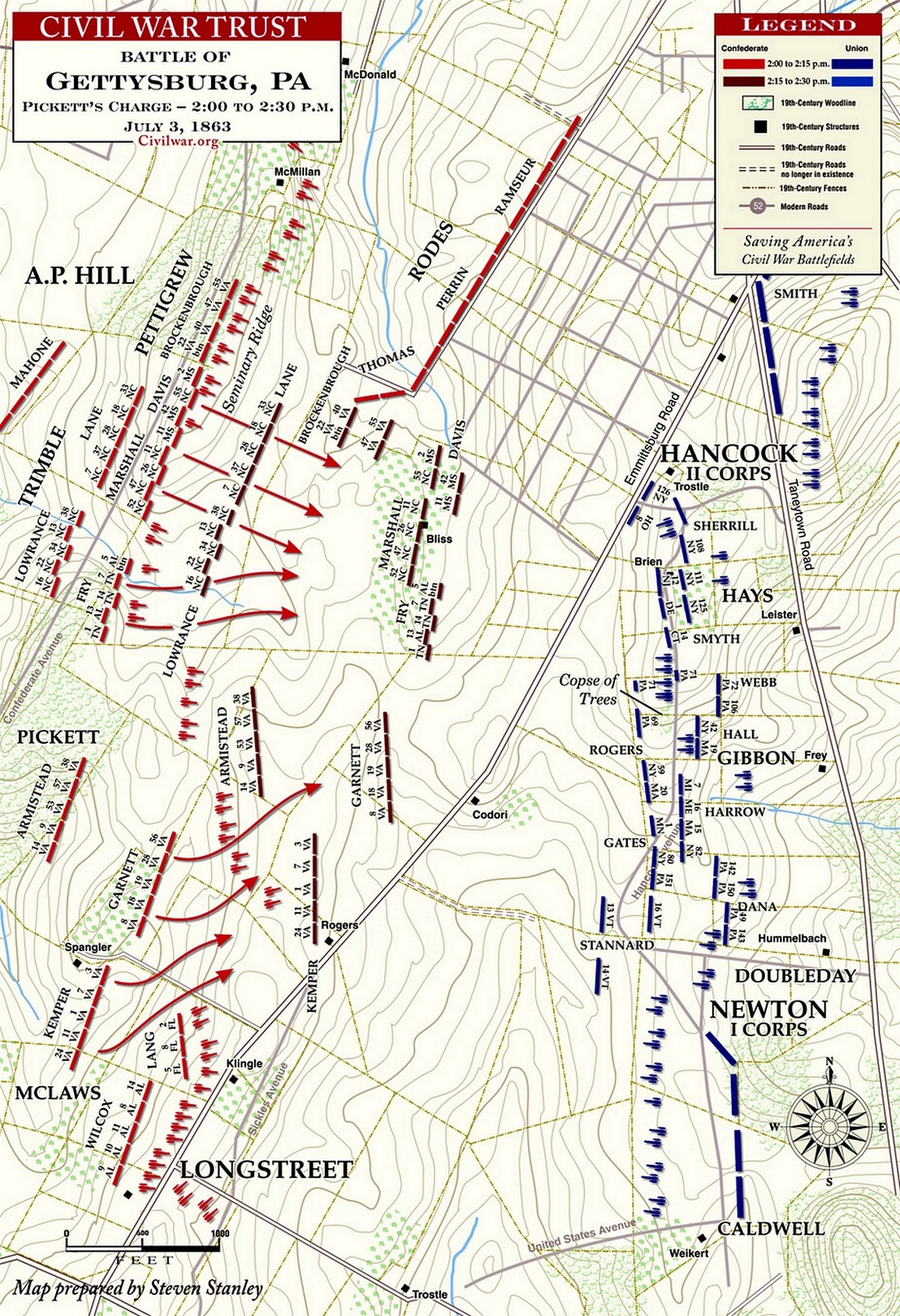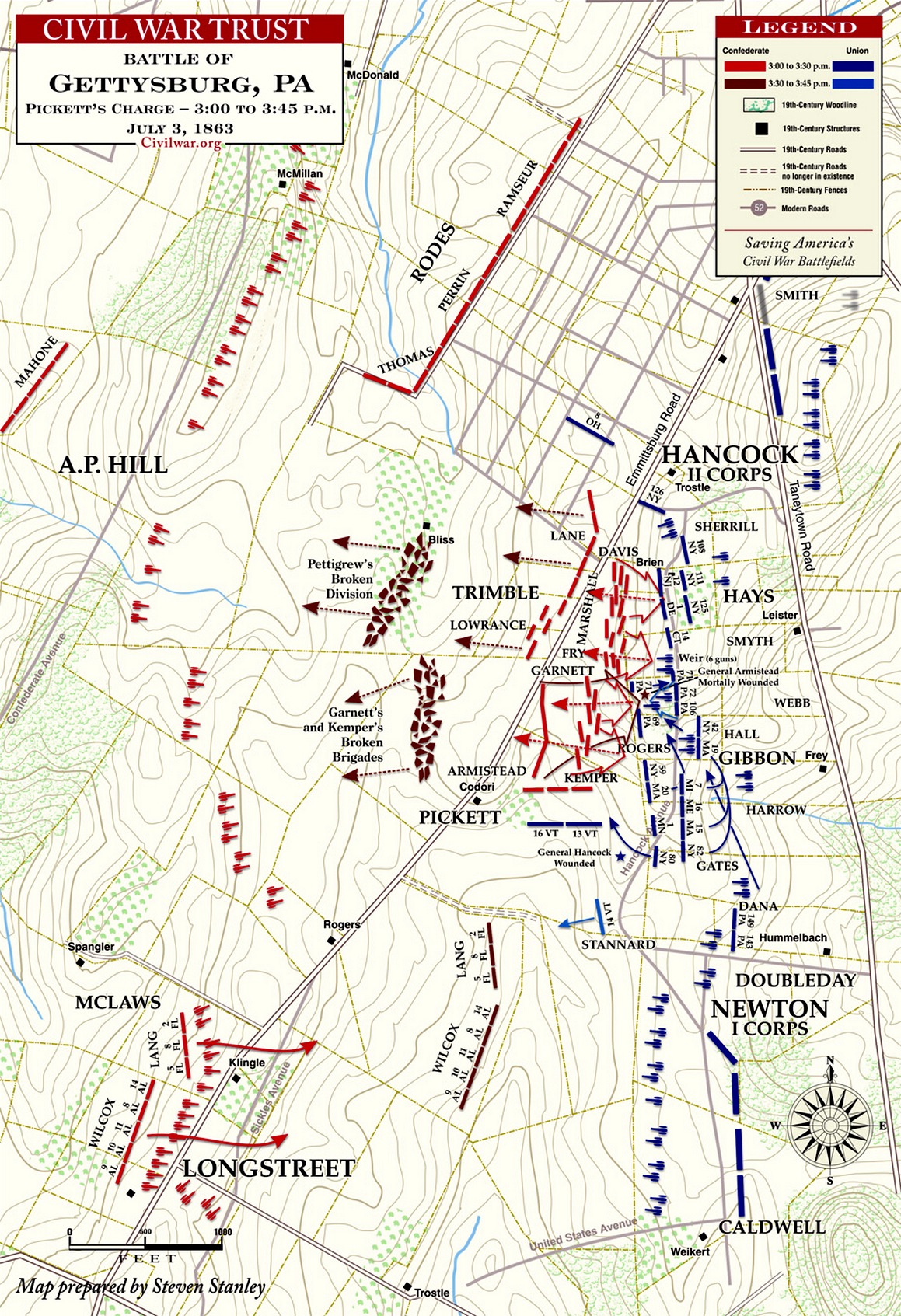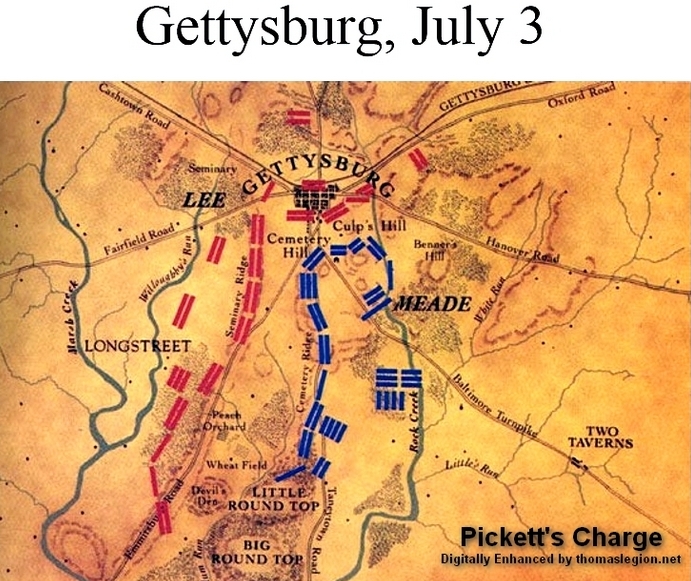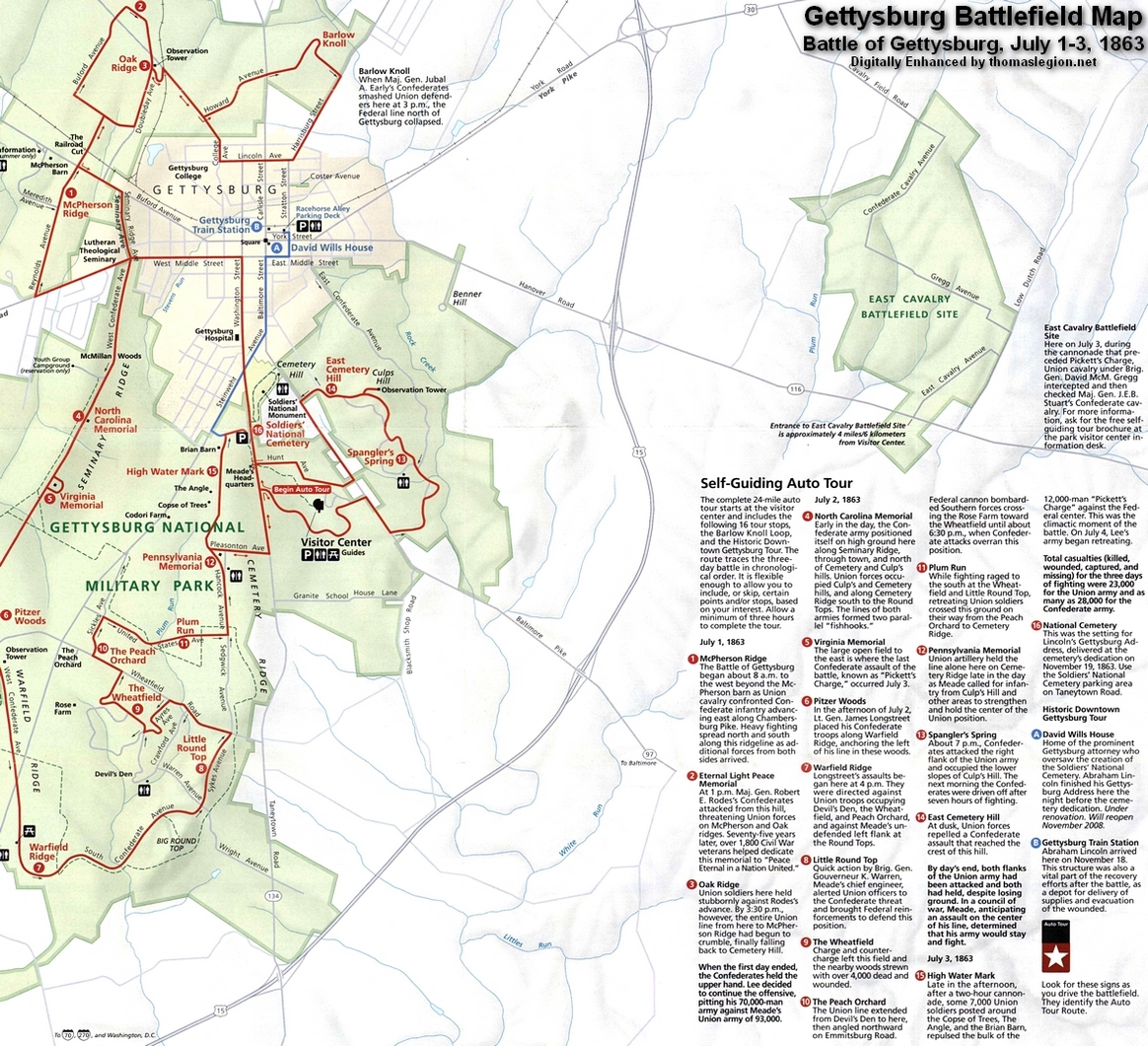|
Pickett's Charge at the Battle of Gettysburg
[From the Richmond, Va., Dispatch, January 26, 1896.]
GETTYSBURG CHARGE.
Paper as to Pickett's Men.
[The following is a compilation of a modest infantryman. Captain Martin W.
Hazlewood is an earnest member of the History Committee of the Grand Camp of Confederate Veterans, Virginia.-ED.]
This interesting paper on the "Gettysburg Charge," was read before Pickett
Camp Monday night, January 20th, by Captain M. W. Hazlewood:
The third day's battle of Gettysburg, more familiarly spoken of as 'Pickett's
charge," has been so often treated in books and essays, that it would seem almost useless to write on the subject at this
late day. In defense of the commanding general, whose conduct has been unwittingly impeached by superficial writers in search
of a scapegoat for the untoward results of this fatal battle, and in justice to the troops engaged, it will hardly be regarded
as out of place to cite some facts which have not ordinarily attracted attention.
On the morning of the 3d of July the Federal line was complete, and occupied
all the hills and ridges from Culp's Hill to Round Top mountain, without a break, while Kilpatrick's cavalry enveloped the
Confederate right, where McLaws and Hood, with about eight thousand men, were confronted by the Fifth and Sixth army corps
occupying an impregnable position. These facts, it would seem, decided General Lee to form a column of attack on the point
where Wright's Brigade had penetrated the Federal line on the previous evening.
AN INTERVIEW WITH LEE.
On the night Of July 3d, General Imboden states that in response to a message
he had an interview with General Lee, during which the latter, in a voice tremulous with emotion, said:
"I never saw troops behave more magnificently than Pickett's Division of Virginians
did to-day in that grand charge upon the enemy. And if they had been supported as they were to have been--but, for some reason
not yet fully explained to me, were not--we would have held the position and the day would have been ours."
This remark of the commanding general has been almost universally construed
as a censure of Heth's and Pender's troops; but this is as unjustifiable as it is untrue. General Lee's official report was
forwarded to the War Department January 20, 1864, more than six months after the battle, and there is not a word in that report
which reflects on these troops.
| Pickett's Charge |

|
| Unit's participating in Pickett's Charge |
THE LINE OF BATTLE.
General Lee gives the order of line of battle as follows:
"General Longstreet ordered forward the column of attack, consisting of Pickett's
and Heth's Divisions, in two lines, Pickett's on the right, Wilcox's Brigade marched in rear of Pickett's right, to guard
that flank, and Heth's was supported by Lane's and Scales's Brigades, under General Trimble."
General Longstreet in his report says: "Pickett's Division was arranged, two
brigades in the front line, supported by his third brigade, and Wilcox's Brigade was ordered to move in rear of his right
flank, to protect it from any force that the enemy might attempt to move against it. Heth's Division, under the command of
Brigadier-General Pettigrew, was arranged in two lines, and these supported by part of Major-General Pender's Division, under
Major-General Trimble. * * * *About 2 P. M. General Pickett, who had been charged with the duty of arranging the lines behind
our batteries, reported that the troops were in order."
It will thus be seen that Heth's Division was a part of the column of attack,
and must not be regarded as a mere support to Pickett.
General Lee further says: "The batteries were directed to be pushed forward
as the infantry progressed, protect their flanks, and support their attacks closely."
These excerpts enable us to give a diagram of the column of attack, as it
should have appeared in accordance with the foregoing orders, when it advanced, to which is added Anderson's three Brigades,
which, as will appear further on, was to be a part of the supporting column.________________________________________________________
FRONT.
RIGHT
LEFT
..............................................0..0..0..0..0..0..0..0
..............................................Nine Howitzers.
Pettigrew.................Archer..............Garnett.............Kemper.
Brockenbrough............Davis......................Armistead..............
Lane...............Scales............................................................Perry...............Wilcox.
Wright..........Posey..........Mahone..........................................................................................
McIntosh...Lane...Garnett...Pegram...Poague...Cabell...Dearing...Eshleman...Alexander...Henry.
REAR.
____________________________________________________________________________
WAS A FORLORN HOPE.
The strength of this formation can be readily apprehended. With a compact
triple line of infantry, supported by some twenty or more batteries, commanded by Colonel E. P. Alexander, masked in what
was virtually one battery, the shock must have been overwhelming. In addition, General Pendleton had placed at the disposal
of Colonel Alexander nine howitzers, belonging to Hill's Corps, with which Alexander says he intended to precede the infantry,
but when sent for they could not be found, some having been removed by order of General Pendleton, and others had changed
their position to avoid the shelling. By comparing the following diagram, which represents the advance as it was made, with
the preceding diagram, it will be realized at a glance that "Pickett's charge" was, indeed, a forlorn hope.
___________________________________________________________________
EAST.
Brockenbrough....Davis....Pettigrew....Archer....Garnett....Kemper.
.......................................... Lane............Scales.............Armistead.........
0...0...0...0...0.......................
.Major Eshleman's....................
five guns..........................
__________________________________________________________________
INFANTRY THAT TOOK PART.
The infantry actually engaged in this memorable conflict are as follows:
Pickett's Division --Kemper's Brigade--First, Third, Seventh,
Eleventh, and Twenty-fourth Virginia Regiments. Garnett's Brigade--Eighth, Eighteenth, Nineteenth, Twenty-eighth and Fifty-sixth
Virginia Regiments. Armistead's Brigade--Ninth, Fourteenth, Thirty-eighth, and Fifty-seventh Virginia Regiments.
Heth's Division --Archer's Brigade--Thirteenth Alabama Regiment
and Fifth Alabama Battalion, and the First, Seventh, and Fourteenth Tennessee Regiments. Pettigrew's Brigade-- Eleventh, Twenty-sixth,
Forty-seventh, and Fifty-second North Carolina Regiments. Davis' Brigade--Second, Eleventh, and Forty-second Mississippi,
and Fifty-fifth North Carolina Regiments. Brockenbrough's Brigade--Fortieth, Forty-seventh, and Fifty-fifth Regiments, and
the Twenty-second Virginia Battalion.
Pender's Division --Scales' Brigade--Thirteenth, Sixteenth,
Twenty-second, Thirty-fourth, and Thirty-ninth North Carolina Regiments. Lane's Brigade--Seventh, Eighteenth, Twenty-eighth,
Thirty-third and Thirty-seventh North Carolina Regiments.
Archer's was made the directing brigade of the line of battle.
| Charge and repulse of Pickett's Division. |

|
| Pickett's Charge is repulsed. |
BEYOND THE STONE WALL.
All these troops, numbering not more than 14,000, had, with the exception
of Pickett's Division, been heavily engaged in the battle of the first of July. Brockenbrough's and Davis's Brigades, with
absolutely no supports on the left or rear, unable to stand the tempest of shot and shell, gave way first. Pettigrew's Brigade
dashed on, and, when within a short distance of the stone wall, a flanking column on the left poured in a destructive fire
of musketry, causing what was left of the brigade to fall back. Archer's Brigade reached nearly, if not quite, the stone wall.
From this point they retired to their former position on Seminary Ridge, passing through in a disorderly mass, and necessarily
demoralizing to some extent the brigades of Lane and Scales, which continued to advance, however, some of the men reaching
within a few yards of the stone wall; but none of the troops, except Pickett's, passed beyond the wall.
A Federal authority says: "Alexander Hays had several regiments well to the
front behind stone walls, and on his extreme right was Woodruff's Battery of light twelves. Whether the fire was closer here,
or whether, as some claim, the troops in Pettigrew's command were not as well seasoned to war as Pickett's men, it is certain
that the attack on Hays was speedily repulsed. That it was pressed with resolution was attested by the dead and wounded on
the field, which were as numerous in Hays's front as on any other part of it."
In the published records it is shown that medals were voted by Congress to
Federal soldiers for flags captured from Pettigrew's, Archer's, and Scales's Brigades, every regiment in Archer's having lost
their colors. The devotion and gallantry of the troops forming the left wing of Pickett's charge cannot justly be questioned.
ORDERS THROUGH THREE COURIERS.
The rear and flank of Pickett's Division was to have been supported by Wilcox
and Perry, but there is good reason for supposing that they did not advance until after the attack had been repulsed. From
General Wilcox's report we learn that about twenty or thirty minutes after Pickett's advance three different couriers came
with orders to advance--one of them from Major-General Anderson, probably a mile distant, to the left. General Wilcox adds:
"Not a man of the division that I was ordered to support could I see."
Colonel Lang, commanding Perry's Brigade, says: "Soon after General Pickett's
troops retired behind our position General Wilcox began to advance, and, in accordance with previous orders to conform to
his movements, I moved forward also."
Colonel Alexander, in an article published since the war, says: "Wilcox's
Brigade passed by us, moving to Pickett's support. There was no longer anything to support, and, with the keenest pity at
the useless waste of life, I saw them advance. The men as they passed us looked bewildered, as if they wondered what they
were expected to do, or why they were there. However, they were soon halted and moved back."
General Anderson, with the remaining brigades of his division--Wright, Posey,
and Mahone--was expected to support the left wing of the column of attack. General A. P. Hill, his corps commander, says:
"Anderson had been directed to hold his division ready to take advantage of any success which might be gained by the assaulting
column, or to support it, if necessary."
General Anderson says: "I received orders to hold my division in readiness
to move up in support, if it should become necessary."
General Longstreet says: "Major-General Anderson's Division was ordered forward
to support and assist the wavering columns of Pettigrew and Trimble."
Anderson did not advance for the reason assigned by himself: "At what I supposed
to be the proper time I was about to move forward Wright's and Posey's brigades, when Lieutenant-General Longstreet directed
me to stop the movement, adding that it was useless, and would only involve unnecessary loss, the assault having failed."
| Pickett's Charge |

|
| Third and Final Day at Battle of Gettysburg |
PICKETT'S REPORT DESTROYED.
Who was responsible for the defective formation will probably never be known.
General Pickett's report was suppressed in compliance with the suggestion contained in the following letter:
General George E. Pickett, Commanding, &c.:
General,--You and your men have crowned yourselves with glory; but we have
the enemy to fight, and must carefully, at this critical moment, guard against dissensions, which the reflections in your
report would create. I will therefore suggest that you destroy both copy and original, substituting one confined to casualties
merely. I hope all will yet be well. I am, with respect,
Your obedient servant,
R. E. Lee, General.
Colonel Walter Harrison, assistant adjutant and inspector-general of Pickett's
Division, in "Pickett's Men," published in 1870, says that "the two other divisions (Heth and Pender) were to move simultaneously
in support, charging in second and third lines." This indicates that there was some idea of a triple line at Pickett's headquarters,
though Colonel Harrison's narrative of the battle in this and other respects is somewhat faulty.
ORDERS MISUNDERSTOOD.
General Pettigrew was killed a few days after the battle, and made no report
of his division. The reasonable inference is that the orders were misunderstood. The fact still remains, however, that five
brigades did not advance to the support of the attacking column, and the left of Pettigrew's line was wholly unsupported.
But there were other and most essential supports ordered to accompany Pickett's
advance. General Lee's report, as before quoted, says: "The batteries were directed to be pushed forward as the infantry progressed,
protect their flanks, and support their attacks closely."
General Longstreet says: "I gave orders for the batteries to refill their
ammunition-chests, and to be prepared to follow up the advance of the infantry."
Major Eshleman reports: "It having been understood by a previous arrangement
that the artillery should advance with the infantry, I immediately directed Captain Miller to advance his and Lieutenant Battle's
batteries. Captain Miller, having suffered severely from the loss of men and horses, could move forward only three pieces
of his own battery and one of Lieutenant Battle's section. Then, with one piece of Major Henry's battalion, under the direction
of Major Haskell, he took position 400 or 500 yards to the front, and opened with deadly effect upon the enemy. With the exception
of these five guns no others advanced."
GENERAL PENDLETON'S EXPLANATION.
The chief of artillery, General W. N. Pendleton, gives this explanation of
the failure of the artillery to support the attacking column:
"Proceeding again to the right, to see about the anticipated advance of the
artillery, delayed beyond expectation, I found, among other difficulties, many batteries getting out or low in ammunition,
and the all-important question of supply received my earnest attention.
"Frequent shell endangering the first corps ordnance-train in the convenient
locality I had assigned it, it had been removed farther back. This necessitated longer time for refilling caissons. What was
worse, the train itself was very limited, so that its stock was soon exhausted, rendering requisite demands upon the reserve-train,
farther off. The whole amount was thus being rapidly reduced. With our means to keep up supply at the rate required for such
a conflict, proved practically impossible. There had to be, therefore, some relaxation of the protracted fire, and some lack
of support for the deferred and attempted advance."
WHAT GENERAL LEE SAID.
This statement is relieved of its ambiguity by General Lee, who tells the
result as follows:
"The troops moved steadily on, under a heavy fire of musketry and artillery,
the main attack being directed against the enemy's left centre. His batteries reopened as soon as they appeared. Our own having
nearly exhausted their ammunition in the protracted cannonade that preceded the infantry, were unable to reply, or render
the necessary support to the attacking party. Owing to this fact, which was unknown to me when the assault took place, the
enemy was enabled to throw a strong force of infantry against our left, already wavering under a concentrated fire of artillery
from the ridge in front, and from Cemetery Hill on the left. It finally gave way, and the right, after penetrating the enemy's
lines, entering his advance works, and capturing some of his artillery, was attacked simultaneously in front and on both flanks,
and driven back with heavy loss."
There is no obscurity in the language of General Lee. The artillery did not
render the necessary support, and, in consequence of this fact, the assault was a disastrous failure. This must be regarded
as a complete vindication of the infantry. No blame can be attached to the officers and men of the artillery service participating
in this fearful battle. They did their work nobly.
IS NO IDLE BOAST.
Taking into consideration the facts referred to in this paper, nearly all
of which are from the official records, it will be seen that it was no vain boast of General Lee when he said of "Pickett's
charge": "If they had been supported, as they were to have been, we would have held the position, and the day would have been
ours."
It is perfectly apparent that General Lee attributed the defeat of Pickett
solely to the failure of the batteries to advance as ordered; and it is equally certain that had the General been informed
of the fact that the supply of ammunition was exhausted, the advance would not have been made at all.
| Gettysburg Battlefield Map |

|
| Pickett's Charge Battlefield Map |
(Source: Southern Historical Society Papers, Vol. 23, pp. 229-237)
Recommended Reading: Pickett's Charge,
by George Stewart. Description: The author has written
an eminently readable, thoroughly enjoyable, and well-researched book on the third day of the Gettysburg battle, July 3, 1863. An especially rewarding read if one has toured, or plans
to visit, the battlefield site. The author's unpretentious, conversational style of writing succeeds in putting the reader
on the ground occupied by both the Confederate and Union forces before, during and after
Pickett's and Pettigrew's famous assault on Meade's Second Corps. Continued below.
Interspersed
with humor and down-to-earth observations concerning battlefield conditions, the author conscientiously describes all aspects
of the battle, from massing of the assault columns and pre-assault artillery barrage to the last shots and the flight of the
surviving rebels back to the safety of their lines… Having visited Gettysburg several years ago, this superb volume makes me
want to go again.
Recommended Reading: Brigades
of Gettysburg: The Union and Confederate Brigades at the Battle
of Gettysburg (Hardcover) (704 Pages). Description:
While the battle of Gettysburg is certainly the
most-studied battle in American history, a comprehensive treatment of the part played by each unit has been ignored. Brigades of Gettysburg fills this void by presenting a complete account of every brigade
unit at Gettysburg and providing a fresh perspective of the
battle. Using the words of enlisted men and officers, the author and renowned Civil War historian, Bradley Gottfried,
weaves a fascinating narrative of the role played by every brigade at the famous three-day battle, as well as a detailed description
of each brigade unit. Continued below...
Organized by
order of battle, each brigade is covered in complete and exhaustive detail: where it fought, who commanded, what constituted
the unit, and how it performed in battle. Innovative in its approach and comprehensive in its coverage, Brigades of Gettysburg is certain to be a classic and indispensable reference for the battle of Gettysburg
for years to come.
Recommended Reading: Pickett's
Charge--The Last Attack at Gettysburg (Hardcover).
Description: Pickett's Charge is probably the best-known
military engagement of the Civil War, widely regarded as the defining moment of the battle of Gettysburg and celebrated as the high-water mark of the Confederacy. But as Earl Hess notes,
the epic stature of Pickett's Charge has grown at the expense of reality, and the facts of the attack have been obscured or
distorted by the legend that surrounds them. With this book, Hess sweeps away the accumulated myths about Pickett's Charge
to provide the definitive history of the engagement. Continued below...
Drawing
on exhaustive research, especially in unpublished personal accounts, he creates a moving narrative of the attack from both
Union
and Confederate perspectives, analyzing its planning, execution, aftermath, and legacy. He also examines the history of the
units involved, their state of readiness, how they maneuvered under fire, and what the men who marched in the ranks thought
about their participation in the assault. Ultimately, Hess explains, such an approach reveals Pickett's Charge both as a case
study in how soldiers deal with combat and as a dramatic example of heroism, failure, and fate on the battlefield.
Recommended
Reading: Pickett's Charge
in History and Memory. Description: Pickett's
Charge--the Confederates' desperate (and failed) attempt to break the Union lines on the third and final day of the Battle
of Gettysburg--is best remembered as the turning point of the U.S. Civil War. But Penn
State historian Carol Reardon reveals how hard it is to remember the
past accurately, especially when an event such as this one so quickly slipped into myth. She writes, "From the time the battle
smoke cleared, Pickett's Charge took on this chameleon-like aspect and, through a variety of carefully constructed nuances,
adjusted superbly to satisfy the changing needs of Northerners, Southerners, and, finally, the entire nation." Continued below...
With care and detail, Reardon's fascinating book teaches a lesson in the uses and misuses
of history.
Recommended
Reading:
Last Chance For Victory: Robert E. Lee And The Gettysburg
Campaign. Description: Long after nearly fifty thousand soldiers shed their blood there, serious misunderstandings
persist about Robert E. Lee's generalship at Gettysburg. What
were Lee's choices before, during, and after the battle? What did he know that caused him to act as he did? Last Chance for
Victory addresses these issues by studying Lee's decisions and the military intelligence he possessed when each was made.
Continued below...
Packed with
new information and original research, Last Chance for Victory draws alarming conclusions to complex issues with precision
and clarity. Readers will never look at Robert E. Lee and Gettysburg the same way again.
Recommended Reading: Pickett's
Charge: Eyewitness Accounts At The Battle Of Gettysburg
(Stackpole Military History Series). Description:
On the final day of the battle of Gettysburg, Robert E. Lee
ordered one of the most famous infantry assaults of all time: Pickett's Charge. Following a thundering artillery barrage,
thousands of Confederates launched a daring frontal attack on the Union line. From their entrenched positions, Federal soldiers
decimated the charging Rebels, leaving the field littered with the fallen and several Southern divisions in tatters. Written
by generals, officers, and enlisted men on both sides, these firsthand accounts offer an up-close look at Civil War combat
and a panoramic view of the carnage of July 3, 1863.
|

